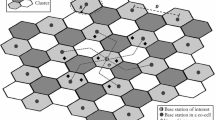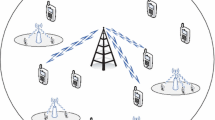Abstract
We propose and study the constrained power control scheme for direct sequence code division multiple access (DS-CDMA) systems supporting voice and data services. In the proposed scheme, the voice users are subject to the conventional power control, while the data users are subject to distance dependent transmit power constraint. Several power control profiles for data users are suggested to reduce interference within its own and neighboring cells. For given delay and outage probability requirements, we present an analytical framework to analyze the number of users that can be supported by the proposed scheme. The results are compared to the conventional power control scheme, where no such constraint is imposed. We derive new closed form expression for the interference correction factor for the constrained power control scheme. In addition, we show that the total interference power can be approximated by the log-normal distribution, and we evaluate the mean and variance of the log-normal distribution analytically. We also derive the distribution of the signal-to-noise ratios for voice and data users, which is useful in evaluating the user capacity for slotted DS-CDMA cellular systems with both delay and power constraints.
Similar content being viewed by others
Abbreviations
- C :
-
User capacity
- β :
-
Path-loss exponent
- r max :
-
Radius of the circle separating the cell area into two power control regions
- δ :
-
Power control profile index
- n v (n d ):
-
Total number of voice (data) users within a cell
- α v (α d ):
-
Activity factor of the voice (data) user
- L d :
-
Packet length (Number of symbols within one packet)
- λ d :
-
Average arrival rate of the newly generated data packets
- Q v (Q d ):
-
Processing gain of the voice (data) user
- \({p_{r_d}}\) :
-
Retransmission probability of the data user
- \({p_{b_d}}\) :
-
Bit error probability of the data user
- R c :
-
Chip rate of the CDMA system
- Ψ v (Ψ d ):
-
SIR threshold for the voice (data) user
- \({P_{out_v}}\) :
-
Outage probability for the voice user
- D th :
-
Delay threshold for the data service
- \({F_{m_v}}\) \({\left(F_{m_d} \right)}\) :
-
Interference correction factor for the voice (data) user
- N :
-
Total number of users within a cell
- η :
-
Density of the mobile terminals
- m v \(\left(\sigma_v^2\right)\) :
-
Logarithmic mean (variance) of the received power from a single voice user
- m d \(\left(\sigma_d^2\right)\) :
-
Logarithmic mean (variance) of the received power from a single data user without power constraint
- μ d \(\left(D_d^2\right)\) :
-
Arithmetic mean (variance) of the received power from a single data user without power constraint
- \(\bar{\mu}_d\) \(\left(\bar{D}_d^2\right)\) :
-
Arithmetic mean (variance) of the average received power from a single data user with power constraint
- \((\cdot)_{vt}\) :
-
Mean or variance of the total interference from voice users
- \((\cdot)_{dt}\) \(\left((\cdot)'_{dt} \right)\) :
-
Mean or variance of the total interference from data users without (with) power constraint
- \((\cdot)_I\) :
-
Mean or variance of the total interference from both services without power constraint
- \((\cdot)^{\prime}_I\) :
-
Mean or variance of the total interference from both services with power constraint
- Note::
-
In order to distinguish the SIR computation of the desired voice user from that of the data user, all notations used in calculations of SI R v are hatted.
References
Wong, T. C., Mark, J. W., & Chua, K. C. (2002, March). Resource allocation in mobile cellular networks with QoS constraints. In Proceedings of Wireless Communications and Networking Conference (pp. 717–722). Orlando, USA.
Kumwilaisak W. et al (2003) A cross-layer quality-of service mapping architecture for video delivery in wireless networks. IEEE Journal on Selected Areas in Communications 21(10): 1685–1698
Alonso L., Agusti R. (2004) Automatic rate adaptation and energy-saving mechanisms based on cross-layer information for packet-switched data networks. IEEE Radio Communications 42: S15–S20
Yao J., Mark J.W., Wong T.C., Chew Y.H. et al (2004) Virtual partitioning resource allocation for multiclass traffic in cellular systems with QoS constraints. IEEE Transactions on Vehicular Technology 53(3): 847–864
Bozinovski, M., Popovski, P., & Gavrilovska, L. (2000). QoS-based policy for call admission control in mobile cellular network. In Proceedings of Wireless Communications and Networking Conference (Vol. 2, pp. 502–506). Chicago, USA.
Comaniciu C., Poor H.V. (2003) Jointly optimal power and admission control for delay sensitive traffic in CDMA networks with LMMSE receivers. IEEE Transactions on Signal Processing 51: 2032–2042
Fenton L.F. (1960) The sum of a log-normal probability distribution in scattered trasmission systems. IRE Transactions on Communications Systems C5(8): 57–67
Huang, W., & Bhargava, V. K. (1996). Performance evaluation of a DS/CDMA cellular system with voice and data services. In The Seventh IEEE International Symposium on Personal, Indoor and Mobile Radio Communications (Vol. 2, pp. 588–592).
Jansen M.G., Prasad R. (1994) Capacity, throughput, and delay analysis of a cellular DS CDMA system with imperfect power control and imperfect sectorization. IEEE Transactions on Vehicular Technology 44(1): 57–75
Kim J.B., Honig M.L. (2000) Resource allocation for multiple calsses of DS-CDMA traffic. IEEE Transactions on Vehicular Technology 49(2): 506–519
Kleinrock L., Tobagi F.A. (1975) Packet switching in radio channels: Part I-carrier sense multiple access modes and their throughput-delay characteristics. IEEE Transactions on Communications COM-23(12): 1400–1416
Chai, C. C., Chew, Y. H., Zhao, Y., & Li, K. (2003). Constrained power control scheme to increase capacity of multi-service systems. In Conference Proceedings, The Fourth International Conference on Information, Communications and Signal Processing (ICICS2003), Singapore, December 15–18, 2003.
Author information
Authors and Affiliations
Corresponding author
Rights and permissions
About this article
Cite this article
Chai, C.C., Zhou, K., Chew, Y.H. et al. Constrained Power Control to Enhance the Capacity of Slotted DS-CDMA Cellular Systems. Wireless Pers Commun 50, 181–206 (2009). https://doi.org/10.1007/s11277-008-9585-z
Received:
Accepted:
Published:
Issue Date:
DOI: https://doi.org/10.1007/s11277-008-9585-z




